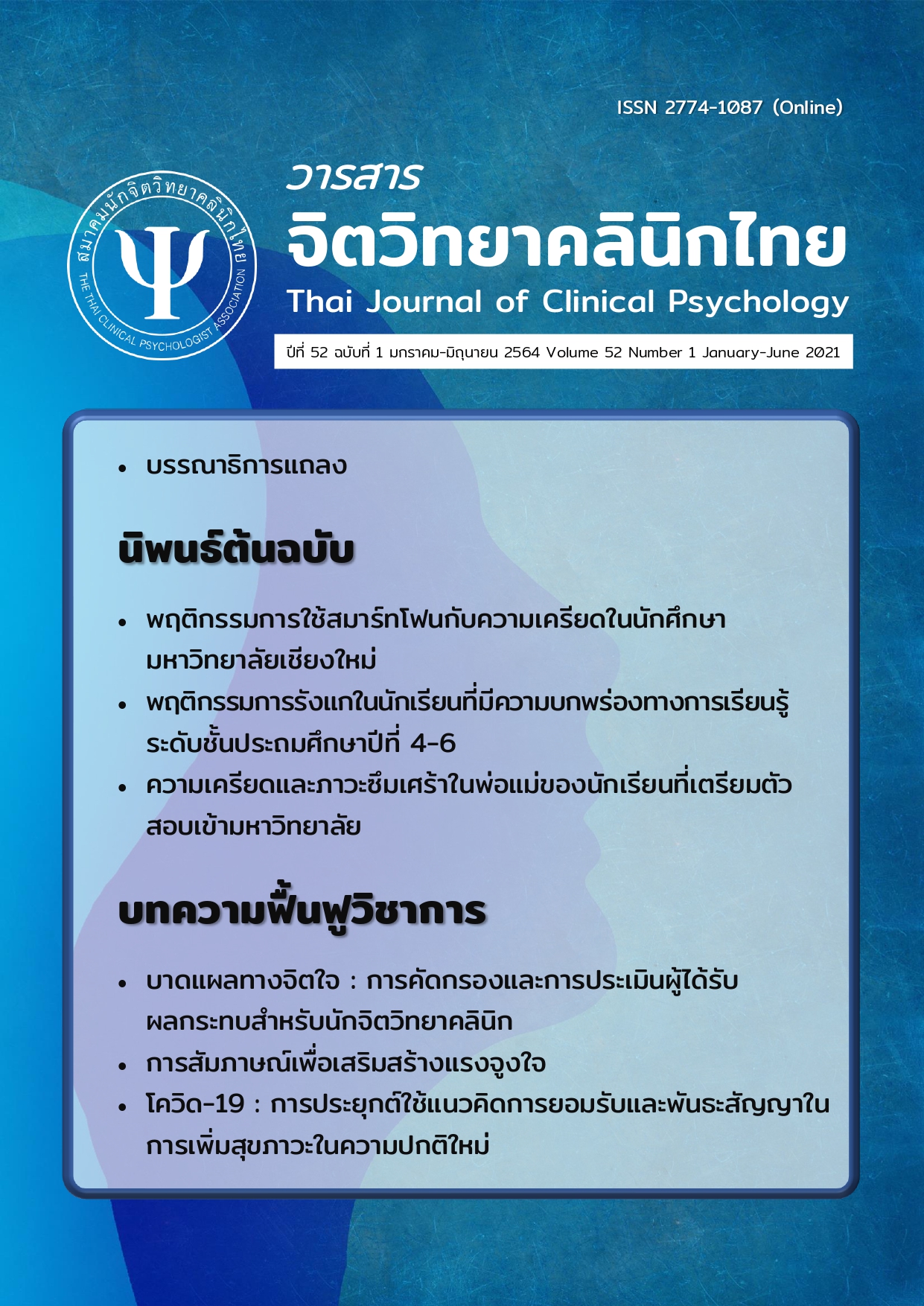ความเครียดและภาวะซึมเศร้าในพ่อแม่ของนักเรียนที่เตรียมตัวสอบเข้ามหาวิทยาลัย
Main Article Content
บทคัดย่อ
วัตถุประสงค์ เพื่อศึกษาความชุกและปัจจัยที่เกี่ยวข้องกับความเครียดและภาวะซึมเศร้าในพ่อแม่ของนักเรียนที่กำลังเตรียมตัวสอบเข้ามหาวิทยาลัย และศึกษาความสัมพันธ์ของความเครียดกับภาวะซึมเศร้าในพ่อแม่กลุ่มดังกล่าว วิธีการศึกษา กลุ่มตัวอย่างคือพ่อแม่ของนักเรียนมัธยมศึกษาปีที่ 6 ปีการศึกษา 2562 และกำลังเตรียมตัวสอบเข้ามหาวิทยาลัย จำนวน 325 คน ผู้วิจัยสุ่มกลุ่มตัวอย่างแบบบังเอิญ โดยกลุ่มตัวอย่างตอบแบบสอบถามด้วยตนเองทางออนไลน์ 3 ชุด คือ แบบสอบถามข้อมูลทั่วไป แบบวัดความเครียดสำหรับคนไทย และมาตรวัดภาวะซึมเศร้าจากแบบวัดสุขภาพจิตในคนไทย วิเคราะห์ข้อมูลด้วยสถิติเชิงบรรยายและค่าสัมประสิทธิ์สหสัมพันธ์ของเพียร์สันและสเปียร์แมน ผลการวิจัย กลุ่มตัวอย่างร้อยละ 45.2 มีความเครียดเล็กน้อย ร้อยละ 35.7 มีสุขภาพจิตปกติ ร้อยละ 16 มีสุขภาพจิตดี ร้อยละ 3.1 มีความเครียดมาก กลุ่มตัวอย่างร้อยละ 72.3 ไม่พบภาวะซึมเศร้าและร้อยละ 27.7 มีภาวะซึมเศร้าระดับควรรับการตรวจวินิจฉัย ความเครียดมีความสัมพันธ์ทางบวกกับเพศ (r = .130) ภาวะซึมเศร้ามีความสัมพันธ์ทางบวกกับแผนการเรียนของบุตร (r = .127) ทั้งผลการเรียนของบุตร รายได้ครอบครัวและความเข้าใจในระบบการสอบเข้ามหาวิทยาลัยของพ่อแม่มีความสัมพันธ์ทางลบกับความเครียด (r = -.147, -.212, -.186) และภาวะซึมเศร้า (r = -.139, -.203, -.162) ความเครียดมีความสัมพันธ์ทางบวกกับภาวะซึมเศร้า (r = .710) อย่างมีนัยสำคัญทางสถิติที่ .05 สรุป พ่อแม่ส่วนใหญ่ของนักเรียนที่กำลังเตรียมตัวสอบเข้ามหาวิทยาลัยมีความเครียดเล็กน้อย มีจำนวนหนึ่งในสามของกลุ่มตัวอย่างที่มีภาวะซึมเศร้าถึงระดับควรรับการตรวจวินิจฉัย ปัจจัยที่เกี่ยวข้องกับความเครียดและภาวะซึมเศร้า ได้แก่ เพศ ผลการเรียนของบุตร แผนการเรียนของบุตร รายได้ของครอบครัว และความเข้าใจในระบบการสอบเข้ามหาวิทยาลัยของพ่อแม่
Article Details
เรื่องที่ลงตีพิมพ์ในวารสารจิตวิทยาคลินิกแล้วถือเป็นลิขสิทธิ์การเผยแพร่โดยวารสารจิตวิทยาคลินิกแต่เพียงผู้เดียว การตีพิมพ์หรือเผยแพร่ซ้ำในที่อื่นต้องได้รับอนุญาตจากกองบรรณาธิการวารสารฯ
เอกสารอ้างอิง
Arayasomboon, P. (2018). Students weigh in on admissions system trouble. Retrieved August 20, 2018, from https://www.bangkokpost.com/lifestyle/social-and-lifestyle/1487418/students-weigh-in-on-admissions-system-trouble.
Assana, S., Laohasiriwong, W., & Rangseekajee, P. (2017). Quality of life, mental health, and educational stress of high school students in the Northeast of Thailand. Journal of Clinical and Diagnostic Research: JCDR, 11(8), VC01-VC06.
Aumkrua, P. (2011). Experience of mathayom suksa 4 students with uncertain decision making in educational plan (Master’s thesis). Chulalongkorn University, Bangkok. (in Thai).
Charan, J., & Biswas, T. (2013). How to calculate sample size for different study designs in medical research?. Indian Journal of Psychological Medicine, 35(2), 121-126.
Cohen, S., Doyle, W. J., & Baum, A. (2006). Socioeconomic status is associated with stress hormones. Psychosomatic Medicine, 68(3), 414-420.
Equitable Education Fund. (2016). Survey report of students and parents’ opinion in preparation for university admission. Retrieved January 2, 2019, from http://www.qlf.or.th/Mobile/Details? contentId=1104 (in Thai).
Feld, L. D., & Shusterman, A. (2015). Into the pressure cooker: Student stress in college preparatory high schools. Journal of Adolescence, 41, 31-42.
Jeon, S. W., Amidfar, M., & Kim, Y. K. (2017). Bio-psycho-social risk factors for depression. In Kim, Y. K. (Ed.), Major depressive disorder: Risk factors, characteristics & treatment options (pp. 71-90). NY: Nova Science Publishers.
Maneesri, K. (2013). General psychology (3rd ed.). Bangkok: Choraka. (in Thai).
Matud, M. P. (2004). Gender differences in stress and coping styles. Personality and Individual Differences, 37(7), 1401-1415.
Mazure, C. M. (1998). Life stressors as risk factors in depression. Clinical Psychology: Science and Practice, 5(3), 291-313.
O’Neil, M. K., Lancee, W. J., & Freeman, S. J. (1986). Psychosocial factors and depressive symptoms. The Journal of Nervous and Mental Disease, 174(1), 15-23.
Phattharayuttawat, S., & Ngamthipwattana, T. (2002). Validity and reliability of the Thai mental health questionnaire. Siriraj Hospital Gazette, 54(9), 540-546.
Phattharayuttawat, S., Ngamthipwattana, T., & Sukhatungkha, K. (1999). The development of psychometric test “the Thai mental health questionnaire”. Siriraj Hospital Gazette, 51(12), 946-952.
Phattharayuttawat, S., Ngamthipwattana, T., & Sukhatungkha, K. (2000). The development of the Thai stress test. Journal of the Psychiatrist Association of Thailand, 45(3), 237-250.
Piccinelli, M., & Wilkinson, G. (2000). Gender differences in depression: Critical review. British Journal of Psychiatry, 177(6), 486-492.
Poole, S., & Snarey, J. (2011). Erikson’s stages of the life cycle. In S. Goldstein & J. Naglieri (Eds.), Encyclopedia of child behavior and development (Vol. 2, pp. 599-603). NY: Springer.
Richter-Levin, G., & Xu, L. (2018). How could stress lead to major depressive disorder?. International Brain Research Organization (IBRO) Reports, 4, 38-43.
Uratanamanee, S., & Lerdsamran, S. (2017). Stress anxiety and depression of high school teenager in preparation for university admission. The Journal of Psychiatric Nursing and Mental Health, 31(2), 72-94. (in Thai).
Veloso, N. G. (2018). The impact of college admissions policies on the academic effort of high school students. Economics of Education Review, 65, 58-92.
Vultaggio, J., & Friedfeld, S. (2013). Stressors in college choice, application, and decision-making-and how to reduce them. Journal of College Admission, 221, 6-12.


